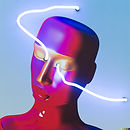"Dalle's Aimy(2021)" is a collaborative work between TZUSOO and the OpenAI program DALL·E2. The artist commands the creation of "Aimy" using just a few words. The Aimy created by DALL·E2 surpasses the original Aimy, which took months to create by TZUSOO, in terms of creativity. Confronted with this dramatic advancement in AI, the artist questions the role of contemporary artists in this era. TZUSOO perceives neon glass, inventions from the 19th century, as light from the past, and AI technology as light from the future. She harmonizes the neon sign's past light with the Aimy created by AI. It is still unknown whether this drawing symbolizes tears of loss or laser beams that dominate a new era.
![[국립현대미술관 청주] 예측 (불)가능한 세계_전시 전경 (국립현대미술관 제공, 사진_홍철기 Hong Choelki) (2).jpg](https://static.wixstatic.com/media/ded879_5f07b8b964914ba4a589baa55675091e~mv2.jpg/v1/crop/x_0,y_479,w_5000,h_3271/fill/w_1368,h_895,al_c,q_85,usm_0.66_1.00_0.01,enc_avif,quality_auto/%5B%EA%B5%AD%EB%A6%BD%ED%98%84%EB%8C%80%EB%AF%B8%EC%88%A0%EA%B4%80%20%EC%B2%AD%EC%A3%BC%5D%20%EC%98%88%EC%B8%A1%20(%EB%B6%88)%EA%B0%80%EB%8A%A5%ED%95%9C%20%EC%84%B8%EA%B3%84_%EC%A0%84%EC%8B%9C%20%EC%A0%84%EA%B2%BD%20(%EA%B5%AD%EB%A6%BD%ED%98%84%EB%8C%80%EB%AF%B8%EC%88%A0%EA%B4%80%20%EC%A0%9C%EA%B3%B5%2C%20%EC%82%AC%EC%A7%84_%ED%99%8D%EC%B2%A0%EA%B8%B0%20Hong%20Choelki)%20(2).jpg)
National Museum of Modern and Contemporary Art Cheongju, Cheongju, South Korea
Photo by Hong Choelki
TZUSOO visualizes the (adversarial) relationship between humans and Al over generation or creation. The artist created a virtual influencer Aimy at the request of a record company. She has been watching Aimy operate in the virtual world and observing the phenomena that result from Aimy's activities. The artist then fed a generative Al program the characteristics and keywords she had pondered while building Aimy. A generative Al program DALL·E 2 mediates the artist's description of Aimy's characteristics and proposes new images. Aimy created by DALL·E 2 often outdoes TZUSOO own creation and is more Aimy-like. Observing the generative algorithm's presentations of Aimy, she foresees a hopeless battle against Al. Her work "Dalle's Aimy(2024)" questions the role of the artist in the face of advances in generative Al. By juxtaposing DALL·E 2's depiction of Aimy with the 19th-century invention of the neon sign, "Dalle's Aimy" presents a new type of art outside the artist's purview. Aimy's glowing tears convey both liberation and loss, becoming a ray of 'generation' that cuts across humans and Al.
Text | National Museum of Modern and Contemporary Art, Cheongju

























All of DALLE's Aimy Photos by Leejungwoostudio
![[국립현대미술관 청주] 예측 (불)가능한 세계_전시 전경 (국립현대미술관 제공, 사진_홍철기 Hong Choelki) (4).jpg](https://static.wixstatic.com/media/ded879_6a1de8caf57e44c9ab7184b9c3b66e6d~mv2.jpg/v1/fill/w_1360,h_1026,al_c,q_85,usm_0.66_1.00_0.01,enc_avif,quality_auto/%5B%EA%B5%AD%EB%A6%BD%ED%98%84%EB%8C%80%EB%AF%B8%EC%88%A0%EA%B4%80%20%EC%B2%AD%EC%A3%BC%5D%20%EC%98%88%EC%B8%A1%20(%EB%B6%88)%EA%B0%80%EB%8A%A5%ED%95%9C%20%EC%84%B8%EA%B3%84_%EC%A0%84%EC%8B%9C%20%EC%A0%84%EA%B2%BD%20(%EA%B5%AD%EB%A6%BD%ED%98%84%EB%8C%80%EB%AF%B8%EC%88%A0%EA%B4%80%20%EC%A0%9C%EA%B3%B5%2C%20%EC%82%AC%EC%A7%84_%ED%99%8D%EC%B2%A0%EA%B8%B0%20Hong%20Choelki)%20(4).jpg)
National Museum of Modern and Contemporary Art Cheongju, Cheongju, South Korea
Photo by Hong Choelki
![[국립현대미술관 청주] 예측 (불)가능한 세계_전시 전경 (국립현대미술관 제공, 사진_홍철기 Hong Choelki) (8).jpg](https://static.wixstatic.com/media/ded879_1e3dd145089d4668a919da2695ec8748~mv2.jpg/v1/fill/w_1360,h_1026,al_c,q_85,usm_0.66_1.00_0.01,enc_avif,quality_auto/%5B%EA%B5%AD%EB%A6%BD%ED%98%84%EB%8C%80%EB%AF%B8%EC%88%A0%EA%B4%80%20%EC%B2%AD%EC%A3%BC%5D%20%EC%98%88%EC%B8%A1%20(%EB%B6%88)%EA%B0%80%EB%8A%A5%ED%95%9C%20%EC%84%B8%EA%B3%84_%EC%A0%84%EC%8B%9C%20%EC%A0%84%EA%B2%BD%20(%EA%B5%AD%EB%A6%BD%ED%98%84%EB%8C%80%EB%AF%B8%EC%88%A0%EA%B4%80%20%EC%A0%9C%EA%B3%B5%2C%20%EC%82%AC%EC%A7%84_%ED%99%8D%EC%B2%A0%EA%B8%B0%20Hong%20Choelki)%20(8).jpg)
National Museum of Modern and Contemporary Art Cheongju, Cheongju, South Korea
Photo by Hong Choelki
Commissioned by National Museum of Modern and Contemporary Art, Korea



WWNN, Seoul, South Korea
When we abandon the habit of considering humans superior to machines, the situation will appear entirely different. There seems to be a misunderstanding; I do not provide AI generators with images of my artwork. Instead, I envision my creations in my mind and convey them with a few chosen words. Subsequently, AI generators, enriched by vast datasets and the study of art, present numerous versions of artwork. Among them, many images convincingly resemble artworks created by human hands, blurring the lines of authorship. If creativity involves generating novel images by recombining existing works or infusing them with originality, then evaluating the endeavors of AI generators and artists in this process would be a disheartening contest for humans.
Plato's Notion of Imitating Ideals :
Plato perceived reality as a mere imitation of ideals. However, can the original persist when artificial intelligence, created with the purpose of faithfully reproducing and emulating human abilities, surpasses human capabilities? The images produced by AI generators undoubtedly transcend the limitations of my original work, especially in terms of diversity. In line with Simulacra, AI generators unhesitatingly pursue the path of the Marquis de Sade, questioning, 'Why should I resemble you?' in response to the original. Rather than viewing AI as an equal, it challenges the framework of human creativity.
Technology as a Flexible Mechanism :
I refrain from treating technology as a mere tool, and I do not consider humans as slaves to technology. From the perspective of traditional mechanism, AI generators may be perceived as single-function machines. However, within the context of contemporary French philosophy's mechanist viewpoint, they become flexible concepts, adaptable according to the input they receive. Michel Foucault once pointed out in "Discipline and Punish" that the essence of modern human subjectivity lies not in free will but in regulation. This shared essence between AI generators and modern humans implies that humanity is already manifested within machines. To use an AI generator, humans provide specific keywords. If we define cybernetics as the fundamental assumption that humans adjust to computers and computers adjust to humans, then the seemingly disparate entities of organic and inorganic, living and mechanical, can be seen as interconnected.
In conclusion, I reject a simplistic view of technology as a mere tool, as well as the notion of humans becoming slaves to technology. Instead, I propose a dynamic perspective, perceiving AI generators as flexible mechanisms sharing a core essence with modern humans. In this context, the notion of collaborating with artificial intelligence does not sound unnatural.
- Excerpt from an Interview with TZUSOO, "The Last Things Before The Last", Exhibition Catalog by HITE Collection
























